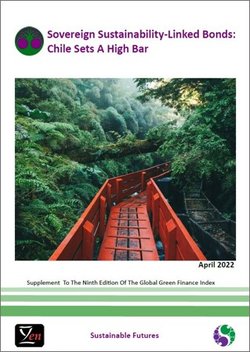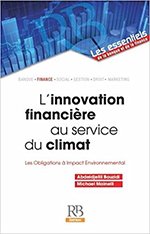Policy Performance Bonds
Policy performance bonds are a simple, and somewhat subversive, idea introduced by Z/Yen in 2005 as part of discussions during the formation of the London Accord. They started being adopted for corporate bonds in 2017, also known as performance incentive bonds or policy performance bonds due to some informal sponsorship of the idea by the French government by the Prime Minister's think-tank (they allowed Professor Mainelli to publish in English!, at first) during COP21 in 2015. This bond sector has been growing rapidly to become a significant portion of the wider 'green bond' market, and spreading outside Europe.
Professor Mainelli's original idea was more directed towards governments than corporates, particularly for preventing climate change. In the case of carbon emissions reduction targets, for example, a policy performance bond (also termed an index-linked carbon bond) is a government issued bond where, in its simplest form, interest payments are linked to the actual greenhouse gas emissions of the issuing country against published targets. An investor in this bond receives an excess return if the issuing country’s emissions are above the government’s published target.

A policy performance bond thus provides a hedge against the issuing country’s government, or a corporate organisation, not delivering on its commitments or targets. Policy performance bonds can be issued against carbon emissions reduction targets but also forest preservation targets and any other area where policy risk is significant. In the case of index-linked carbon bonds, the ability to hedge enables the same investor to invest more confidently in projects or technologies that pay off in a low-carbon future because if the low-carbon future fails to arrive the government too bears direct costs of having to pay higher interest rates on government debt. Index-linked carbon bonds eliminate the one risk that differentiates clean tech projects from other energy projects, the uncertainty of government policy actually being directed at a low carbon future. Examples of potential indices that address this unique risk are:
- Levels of greenhouse gas emissions;
- Levels of feed-in tariffs for renewable energy or percentage of renewable energy in overall energy supply;
- Prices of emission (reduction) certificates in a trading system;
- Levels of taxes on fossil fuels or fossil fuel end-user prices.
The idea was first formally presented by Dr Kevin Parker of Z/Yen at the World Bank Government Borrowers' Forum in Ljubljana in May 2009. The same idea can be used for index-linked forestry bonds on forestry cover, etc. Since first mooted by Long Finance in 2008 & 2009, the private sector began issuing these bonds, tying interest rates inversely to performance against the achievement of environmental, social, or governance goals (our touchstone, as opposed to saying the proceeds will be used for ESG purposes), in 2017. The terms "sustainability-linked finance" or "positive incentive loan" are sometimes used:
- Khazanah (2017) raises RM100 million from second tranche of Sustainable and Responsible Investment (SRI) Sukuk tied to educational attainment - https://www.khazanah.com.my/news_press_releases/khazanah-raises-rm100-million-from-second-tranche-of-sustainable-and-responsible-investment-sri-sukuk/
- Danone (2018) - "positive incentive loan" facility based on independent ESG targets - https://cib.bnpparibas.com/sustain/danone-s-positive-incentive-financing-strategy_a-3-2238.html
- Louis Dreyfus (2019) - green goals such as CO2 reduction, power consumption, water usage, and landfill waste - https://www.businessgreen.com/bg/news/3076513/louis-dreyfus-company-agrees-usd750m-green-loan-repayment-deal
- Nokia (2019) - reducing greenhouse gas emissions - https://www.ft.com/content/6a41a968-9265-11e9-aea1-2b1d33ac3271
- Enel (2019) - clean energy (SDG 7), industry, innovation and infrastructure (SDG 9), sustainable cities and communities (SDG 11), and climate action (SDG 13) - https://renewablesnow.com/news/enel-issues-usd-15bn-sdg-linked-bond-668049/
- Wilmar International Limited (2018) - https://www.dbs.com/newsroom/DBS_and_Wilmar_sign_USD_100_million_sustainability_linked_loan
- Bunge Finance Europe BV (2019) - (1) reducing greenhouse gas emissions by improving industrial efficiency; (2) increasing traceability for main agricultural commodities; (3) supporting increasing levels of adoption of sustainable practices across the wider soybean and palm supply chain - https://www.bunge.com/news/bunge-limited-closes-its-first-sustainability-linked-revolving-credit-facility
- MásMóvil (2019) - ESG targets - https://www.spglobal.com/marketintelligence/en/news-insights/trending/T50laBi-4dsSukOd4pElYg2
- COFCO International (2019) - (1) ESG performance; (2) traceability of agri-commodities - https://www.cofcointernational.com/newsroom/cofco-international-links-sustainability-performance-to-new-usd-21-billion-credit-facility/
- WSP (2020) - (1) reducing greenhouse emissions across global operations; (2) increasing percentage of “Green” Revenues; (3) increasing percentage of management positions held by women https://markets.businessinsider.com/news/stocks/bnp-paribas-closes-sustainability-linked-syndicated-credit-facility-with-wsp-global-1028871879
- Schneider Electric (2020) - paying an extra 0.5% if they fail to meet an average of three sustainability performance targets https://www.se.com/ww/en/assets/564/document/174193/release-sustainability-linked-bonds.pdf
- The Renewables Infrastructure Group, TRIG (2021) - £500 million revolving credit facility with interest linked to (1) environmental: increase in the number of homes powered by clean energy from TRIG’s portfolio; (2) social: increase in the number of community funds supported by TRIG; (3) governance: maintaining a low Lost Time Accident Frequency Rate (LTAFR) - https://www.lse.co.uk/rns/TRIG/trig-secures-163500m-esg-linked-sonia-facility-93l7s4fqews0mp2.html
- Bank of China (2021) - listed six sustainable bonds worth $2.2 billion at the London Stock Exchange on 12 November, with an innovative 'Sustainability Re-linked' bond issued in October, a three year, $300million issue by Bank of China, London Branch with interest payments linked to specific sustainability performance targets - https://www.globaltimes.cn/page/202111/1238853.shtml
- Chile (March 2022) - "Chile issued the world's first sovereign sustainability linked bond ... The $2 billion sustainability-linked bond was issued March 2, carrying a 4.346% rate or 200 basis points above 20-year U.S. Treasury notes. Demand for the bond reached more than $8 billion, or 4.1 times the original placed amount, spread across investors in Europe, Asia and the Americas. Finance Minister Rodrigo Cerda noted this was a sign of confidence in the Chilean economy. The bond adheres to the Paris Agreement on climate change, including that the country emit no more than 95 metric tons of carbon dioxide and equivalent by 2030 and that 60% of electricity production be derived from renewable energy by 2032." - https://www.longfinance.net/media/documents/policy_performance_bond_supplement_1.3_SM_220506.pdf.
- Petrobras (July 2022) - Petrobras signed a US$1.25 billion sustainability-linked loan with Bank of China, MUFG and The Bank of Nova Scotia. "Petrobras will pay a lower interest rate if it improves on key measures of reducing per-barrel emissions of methane and other greenhouse gases." - https://www.bloomberg.com/news/articles/2022-07-11/petrobras-debuts-in-green-financing-with-1-25-billion-loan
- Uruguay (October 2022) - "Uruguay Issues Global Sustainability-Linked Bond, With IDB Support" - "The issue attracted 188 investors from Europe, Asia, the United States, and Latin America, of whom 21% are new holders of Uruguayan debt. Total demand for the bond was $3.96 billion, greatly exceeding the $1.5 billion Uruguay decided to issue. The yield spread between this bond and the US Treasury bond used as a benchmark is 170 basis points. If the bond’s goals are met, its spread will narrow by up to 30 basis points." - https://www.iadb.org/en/news/uruguay-issues-global-sustainability-linked-bond-idb-support
A series of bond 'flavours' seem to be emerging, in increasing order of earnestness:
- green (claim that proceeds will be used for green projects);
- sustainability or ESG (claim that proceeds will be used for wider ESG goals);
- sustainability or ESG where the issuer will report directly on the target(s), e.g. Alphabet/Google's US$5.75 billion (2020) issue will report on progress of project investments in energy efficiency, renewable energy, green buildings, clean transport, circular economy & design, affordable housing, racial equality, and support for small businesses in the wake of Covid-19;
- policy performance bonds – where the issuer puts its money where its mouth is, i.e. interest payments are linked to achievement.
We are delighted with the help we got in France to push the idea among French and Continental corporates. We're particularly pleased with Chile, but also rapid market growth:
"Global sales of sustainability-linked bonds, a subset of ESG debt, hit a record $110 billion last year, compared with $11 billion issued in 2020, according to data compiled by Bloomberg. Moody’s ESG Solutions expects issuance of the debt to hit $150 billion this year."
So, which other governments are prepared to put monies where their policy mouths are?
Related Reports:

Sovereign Sustainability-Linked Bonds: Chile Sets A High Bar - This supplement to the ninth edition of the Global Green Finance Index takes as it subject green-bonds, a product which has been credited with turbo-charging the green finance revolution. In this report we examine the lessons learned by Chile in the development of a new type of green bond — sovereign sustainability-linked bonds (aka policy performance bonds), which are likely to have a significant impact on sovereign debt markets as other nations join Chile to deliver sustainable growth.
An even briefer two page summary is here:
Related Books:

L’Innovation Financière Au Service Du Climat: Les Obligations Á Impact Environnemental
by Abdeldjellil Bouzidi & Michael Mainelli,
ISBN 978-2-86-325784-5
February 2017
Related Articles:
- ICAEW, "Policy Performance Bonds Are A Climate Action 'Game Changer'", ICAEW (3 November 2021).
- Michael Mainelli & Eoin Murray, "Ahead Of The Curve - Green Assets: An Alternative To Green Bonds", Investment & Pensions Europe, IPE International Publishers Ltd (July/August 2021).
- Michael Mainelli & Djellil Bouzidi, "How Government Policy Performance Bonds Could Save The Planet", Official Monetary And Financial Institutions Forum (OMFIF) Sustainable Policy Institute (September 2020), pages 12-13.
- Abdeldjellil Bouzidi, "The Case For Sovereign Climate Bonds", Official Monetary And Financial Institutions Forum (January 2017).
- Abdeldjellil Bouzidi & Michael Mainelli, "Environmental Policy Performance Bonds Poster", 3rd Geneva Summit on Sustainable Finance (Latsis Symposium, March 2016).
- Abdeldjellil Bouzidi and Michael Mainelli, "Environmental Policy Performance Bonds", France Stratégie (Prime Minister’s Think Tank) (9 November 2015).
- Abdeldjellil Bouzidi & Michael Mainelli, "Environmental Policy Performance Bonds" in UNA-UK, Climate 2020: Facing the Future (June 2015), pages 152-153.
- House of Commons' Environmental Audit Committee, "Green Finance: 12th Report of Session 2013-14" (March 2014).
- Michael Mainelli & Jan-Peter Onstwedder, "Living Up to Their Promises" (index-linked carbon bonds), Environmental Finance, Fulton Publishing (February 2010), page 17.
- Michael Mainelli, “Index-Linked Carbon Bonds”, Delivering Copenhagen: The Role Of The City’s Financial Services Sector In Supporting Action On Climate Change, Liz Bossley (ed), City Of London submission to COP 15 (2009), pages 15-20.
- Michael Mainelli, "Gilding Government Debt", Journal of Risk Finance, Volume 10, Number 5, Emerald Group Publishing Limited (November 2009), pages 537-39.
- Michael Mainelli, "Over the Hedge", Petroleum Review, Energy Institute (November 2009), page 16.
- Michael Mainelli & Jan-Peter Onstwedder, "Carbon Debts: Index Linked Carbon Bonds", Ecosystem Marketplace, Katoomba Group (9 April 2009).
- Michael Mainelli, Jan-Peter Onstwedder, Kevin Parker, William Fischer, "Index Linked Carbon Bonds - Gilty Green Government", Z/Yen Group Limited (April 2009).
Media Coverage:
- ICAEW Viewpoints, Policy Performance Bonds Are A Climate Action “Game Changer”, Institute Of Chartered Accountants In England & Wales (3 November 2021).
- L'actualité Économique Déchiffrée par les Économistes du CEPII, "Environmental Policy Performance Bonds" (12 November 2015).
- France Stratégie, "Environmental Policy Performance Bonds" (9 November 2015).
- Revue Banque, "Obligations CO2 : Faire des États des Émetteurs Verts" (27 October 2015).
- Environmental Finance, "Three G10 Governments 'mulling climate-linked bonds'" (3 December 2009).
- FT Adviser, "Special Report: SRI - Powering Towards a Low-Carbon Future" (13 October 2009).
- Michael Mainelli on 10 November 2009 spoke on the BBC World Service Business Daily Programme, addressing "Index-Linked Carbon Bonds" (listen from 13.50).